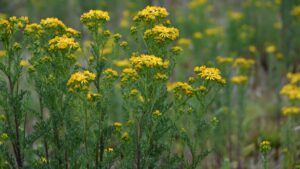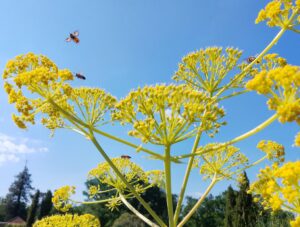
Podcast Episode 36 – The Dove From Above
PODCAST EPISODE 36: The Dove From Above Join us on a beautiful June evening for episode 36 of the Knepp Wildland Podcast. We’re joined by
Home / The Journey to Wilding the Garden ~ March 2020
It is difficult to remember now, at the end of this month, how life was before Covid 19 entered all our lives. The small cherry picker, [still a fourteen metre stretch], was booked for the first week, and our anxieties then about the rain holding off seem so minor in comparison. Yet we hoped our endeavours to prepare the climbing roses had paid off, and as we made our slow droning ascent to the crenellations, we would be able to finish them all. Despite a late torrential assault that shook the ‘cage’ along with Suzi and Craig inside it, the green coverings of the castle walls now look a little less disheveled and will bloom a little more in May and June.
The rainy days began to ease, the peach unfurled its fat pink buds to blossom under its cover and green shoots were pushing aside the soil and rising to the sun. It felt too early to begin cutting back all those over wintering stems and seedheads; it’s a long time until May and casting off their ‘clout’ of frost protection is always a gamble once it’s removed. With the bones and husks of last season cleared away the garden shows its shape, and the spaces that could be filled with nectar and pollen sources for those early emerging insects. We’ve seen plenty of queen bumble bees and the Osmanthus delaveyi was humming with the honeybees from the log hive by the greenhouse.
Tom sent through the plant list for the first phase of the Kitchen Garden design. Much of the central beds remain the same at this stage, new planting being concentrated along the north and east walls. Nearly all the plants are edible or culinary, some we were unfamiliar with; Aronia x prunifolia, purple chokeberry with hawthorn -like flowers and autumn leaf colour, Drimys lanceolata, Tasmanian mountain pepper with cinnamon scented bark and leaves or Zanthoxylum simulans from which Sichuan pepper is produced.
We began to remove some of the existing shrubs and roses to make space, which luckily coincided with a new raised bed being built at the campsite that needed to be planted up. Others will no doubt eventually find homes around the rest of the estate. Yas continues to log the changes on her monthly repeated photography route, while Ned has kindly volunteered to arrange fixed point cameras on the greenhouse roof to record the transformation of the kitchen and south gardens over a year.

Lacewing larvae eating an aphid
With the sun and the warmth continuing hundreds of seeds germinated and seedlings were pricked out, but while growth rate exploded, so too did the populations of unwanted guests. Flea beetle on the mizuna in the raised beds and aphids in the greenhouse. The first lacewing larvae of the season were dispatched to us and shaken among the citrus and the orchids now in flower, ants already moving in to collect the honeydew and farm the greenfly. We’ll companion plant among the vegetables and salad outside, umbels like fennel and caraway and simple flowers like pot marigolds that bring microscopic wasps and flies to the nectar and pollen source. Their larvae parasitise the flea beetle while the interplanting has the added bonus of looking rather lovely as well.
Shortly after we called an end to rose pruning, as dormancy broke and leaves flourished, the historic televised address to the nation called an end to what I suppose we now call the ‘old normal’. Poor Suzi was left to battle on with the plant order preparations while both Karen and I succumbed to corona symptoms. There are an awful lot more door handles, taps and light switches in our lives than we realised, and Suzi has become intimately acquainted with all of them.

The Euphorbia amongst the Buddleja in the walled garden
We are uncommonly lucky to be surrounded in our working life by what many others might turn to for therapy in times of trouble. Spring continues unperturbed, blackthorn and cherry blossom bombs your peripheral vision, the acid yellow heads of Euphorbias jostle with last year’s Buddleja stems, waiting to be cut back. Penny has begun the garden survey with a moth trap and Graeme Lyons brought his insect hoover and butterfly net to sweep some selected paths through the garden, the first of six monthly tours. He was surprised by how much invertebrate life was in the grass areas, and found a pseudo scorpion, apparently a rare visitor.
We’ll take the positives we can from the lockdown. Those confines that are given ask us to let go, to allow the pace to slow, to value small simple moments, all valuable lessons in rewilding ourselves as well as the garden.
Moy Fierheller, Joint Head Gardener
What we are reading:
http://digdelve.com/a-new-world/
Butterfly brothers wild your garden

PODCAST EPISODE 36: The Dove From Above Join us on a beautiful June evening for episode 36 of the Knepp Wildland Podcast. We’re joined by

Matt Phelps | Lead Ecologist It’s mid-June and the countryside is quietly gearing up for its summer crescendo. You might have noticed it already— what

Moy Fierheller | Deputy Head Gardener Visit Knepp’s rewilded Walled Garden The fine, fairy-tale spring continues and the Met Office reports it’s the sunniest in
Knepp Wildland Safaris, our gardens and campsite are all about the quiet and patient observation of nature.
Some of the species we are likely to encounter are shy or can be frightened by loud noises or sudden movements. Our campsite with open-air fire-pits, wood-burning stoves and an on-site pond is unsuitable for small children.
For this reason, our safaris, garden visits, holiday cottages and campsite are suitable only for children of 12 and over.